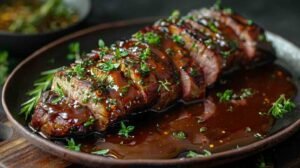Corned Beef and Cabbage Recipe: 5 Easy Steps
Corned Beef and Cabbage Overview
Corned beef and cabbage is a classic Irish-American meal that takes time to make. The meat is cooked slowly to make it soft and tasty. “Corned” means the big pieces of salt used to preserve the meat in the past. To make this dish, I usually start with a brisket. The brisket is soaked in salty water with different spices. This gives the corned beef its special pink colour and salty flavour.
To make this meal, the corned beef is usually cooked in water for a long time until it gets soft. Sometimes, people add more spices to the water. It can take a few hours to cook. After the meat is almost done, I like to put in strong veggies like potatoes, carrots, and cabbage. I add them to the same pot near the end of cooking. The veggies take in the flavours from the broth, making the whole dish taste even better.
People can make corned beef and cabbage in different ways. For example, I might bake the corned beef in the oven after boiling it to make the outside crispy. But most of the time, we cook everything together in one pot. This dish is easy to make in big batches. That’s why it’s popular for family get-togethers, especially on St. Patrick’s Day. Here’s a basic outline of how I organize the cooking process:
- Brine the beef: Soak the beef in a seasoned brine, then rinse and pat dry before cooking.
- Cook the beef: Simmer the meat until tender, a process that can take a couple of hours.
- Prepare the vegetables: While the beef is cooking, I prepare the carrots, potatoes, and cabbage.
- Cook the vegetables: Add the vegetables to the pot during the final cooking stage.
- Rest and slice: After removing the meat from the pot, I let it rest to retain the juices before slicing.
This dish’s fame comes from its association with Irish-American culture and is widely enjoyed on festive occasions.
Ingredients and Substitutions for Corned Beef and Cabbage Recipe
Here’s a list of the main ingredients you’ll need for a classic Corned Beef and Cabbage recipe, along with some ideas for substitutions to fit different diets and what you might have on hand:
Main Ingredients
- Corned Beef Brisket: A pre-cured beef brisket that is the star of this dish. It’s essential for the characteristic flavour.
- Cabbage: Typically green cabbage is used, cut into wedges.
- Potatoes: Small red or gold potatoes are common, left whole if small or halved if larger.
- Carrots: Peeled and cut into chunks for even cooking.
Seasonings and Spices
- Garlic: Fresh cloves enhance the dish’s flavour.
- Bay Leaf: Adds aromatic depth.
- Black Pepper: Freshly ground is preferred for seasoning.
A spice packet often comes with the corned beef brisket, which typically includes:
- Mustard Seeds
- Coriander Seeds
- Allspice Berries
- Red Pepper Flakes
- Clove
Alternative Ingredients
Corned Beef Substitutes:
- Tempeh or Seitan: For a vegetarian twist, with adjustments to cooking time.
- Tofu: Extra-firm, seasoned well, can provide a protein-rich alternative.
Potatoes and Carrots Substitutes:
- Sweet Potatoes: An alternative to white potatoes that adds a different flavour profile and is rich in vitamins.
- Parsnips: Similar to carrots, with a sweeter, nuttier taste.
Seasoning Substitutions:
Adjust the spices based on your preference or availability.
- Apple Cider Vinegar: Can replace white vinegar for a milder tang.
- Brown Sugar: For a touch of sweetness, if desired.
Preparation Steps
When I make Corned Beef and Cabbage, I like to get the meat and veggies ready in a certain order. Then, I cook them in a way that brings out all their tasty flavours.
Meat Preparation
Firstly, I select a piece of corned beef brisket and rinse it to remove excess brine. I place it in a large Dutch oven or a stockpot and cover it with water or broth to ensure the meat cooks evenly and remains moist. Depending on the size and cut, the meat is brought to a boil and then simmered for about 2 to 3 hours or until it’s tender.
Vegetable Preparation
While the corned beef is simmering, I prepare the vegetables. When I’m getting the veggies ready, I start by washing the red potatoes and cutting them in half. This helps them cook evenly. Next, I peel the carrots and cut them into pieces about 2 inches long. For the cabbage, I cut it into wedges. I make sure not to cut the wedges too thin, so they don’t get too soft while cooking. These veggies will later be added to the pot in stages.
Cooking Process
Once the meat is tender, I add the potatoes and carrots into the pot. They typically need to simmer for about 20-30 minutes before they’re almost tender. I then add the cabbage on top and let it cook for another 15 minutes. The vegetables should be tender, but not mushy. I remove the meat and let it rest before slicing it against the grain to serve. During resting, the corned beef reabsorbs some of the juices, making it moist and flavourful.
Serving and Pairing Suggestions
When I make corned beef and cabbage, it’s important to pick side dishes that go well with the tastes and textures of the main meal. Here’s a succinct guide to pairing this hearty dish:
Textures & Flavours: Since corned beef is tender and the cabbage is soft, I aim for sides with a bit of crunch or a contrasting texture. A tangy coleslaw or a refreshing cucumber salad makes an excellent counterpart.
Vegetables: I consider vegetables that can withstand the strong flavour of corned beef. Roasted Brussels sprouts or glazed carrots add a hint of sweetness while bringing a vibrant colour to the plate.
Potatoes: A classic pairing is potatoes, and I like them best when they’re crispy on the outside but fluffy inside. Potato wedges are simple and effective, but for a richer option, a creamy potato gratin adds a luxurious touch.
Breads: To soak up the flavourful juices, I find that rye bread or garlic bread serves well. Their robust flavours pair nicely with the corned beef.
Healthier Options: For more balanced meal, I sometimes opt for sides like cauliflower rice or a green bean casserole to keep things lighter.
Here’s a quick list of my go-to side dishes:
- Crisp Sides: Coleslaw, cucumber salad
- Vegetables: Roasted Brussels sprouts, glazed carrots
- Potatoes: Potato wedges, potato gratin
- Breads: Rye bread, garlic bread
- Lighter Options: Cauliflower rice, green bean casserole
Each option brings its own unique taste and texture, creating a well-rounded meal around the main attraction of corned beef and cabbage.
Storage and Reheating Instructions
After cooking corned beef and cabbage, I always let it cool down to room temperature before storing it. This helps stop bacteria from growing. I separate the beef and cabbage and put them in different containers that are airtight. Once the containers are in the fridge, the corned beef will stay good for about four days. But it’s best to eat the cabbage within a day or two to keep it fresh and tasty.
For reheating, I prioritize methods that maintain the moisture and flavour of the corned beef. Here’s a quick guide I follow:
Corned Beef:
- Oven method: Wrap corned beef in aluminium foil and add a tablespoon of broth or water. I reheat it in a preheated 275°F oven until it reaches an internal temperature of 165°F.
Cabbage:
- Microwave: Place cabbage in a microwave-safe dish with a splash of water, cover it with a damp paper towel, and heat it for 1-2 minutes on high, checking and stirring every 30 seconds.
When I’m in a hurry, the microwave works for the corned beef as well, but I take care to cover it and use a lower power setting to avoid drying it out. It’s not my preferred method, but it gets the job done quickly.
A tip I always keep in mind: I avoid high heat for reheating, as it can make the corned beef tough and the cabbage mushy. Gentle reheating ensures the meat stays tender and the vegetables retain their texture.
Check our another article Au Jus Recipe – Let’s Celebrate Legacy
Frequently Asked Questions about Corned Beef and Cabbage Recipe
Navigating through the nuances of preparing traditional dishes like corned beef and cabbage can lead to questions. I aim to clarify common inquiries with concise, focused answers.
1. How can you cook canned corned beef and cabbage to maintain its flavour?
For canned corned beef, I find it best to add the beef to the cabbage during the final minutes of cooking. This prevents it from becoming overly soft and helps preserve its signature taste.
2. What are some tips for making an easy corned beef and cabbage dish?
I recommend using a one-pot method with corned beef, vegetables, and spices simmered together. This simplifies the process and infuses the cabbage with the rich flavours of the corned beef.
3. What’s the ideal temperature and time to cook corned beef and cabbage in the oven?
To bake corned beef and cabbage in the oven, I usually set the temperature to 325°F. Then, I cook it for around 2 to 3 hours. I check the beef with a fork to make sure it’s nice and tender before taking it out of the oven.
4. Which ingredients are essential for the best tasting corned beef and cabbage?
To make a tasty corned beef and cabbage dish, you need a few key things. First, get a good quality corned beef. Then, pick out a fresh cabbage, some carrots, and onions. For extra flavor, add a mix of spices like mustard seeds, peppercorns, and bay leaves.
5. Can you provide tips for cooking tender corned beef in a slow cooker?
To ensure tenderness when using a slow cooker, submerge the corned beef in liquid with spices and cook on low for about 8-10 hours. Adding vegetables during the last few hours keeps them from becoming too soft.
6. What are the steps to create an authentic Irish corned beef and cabbage meal?
To make corned beef and cabbage the Irish way, first put the corned beef in a pot with water, onions, garlic, and spices. Let it simmer until it’s almost soft. Let it simmer until it’s almost tender. Then, add in potatoes and carrots. In the last hour of cooking, put in the cabbage wedges. This way, all the flavours come together nicely.



